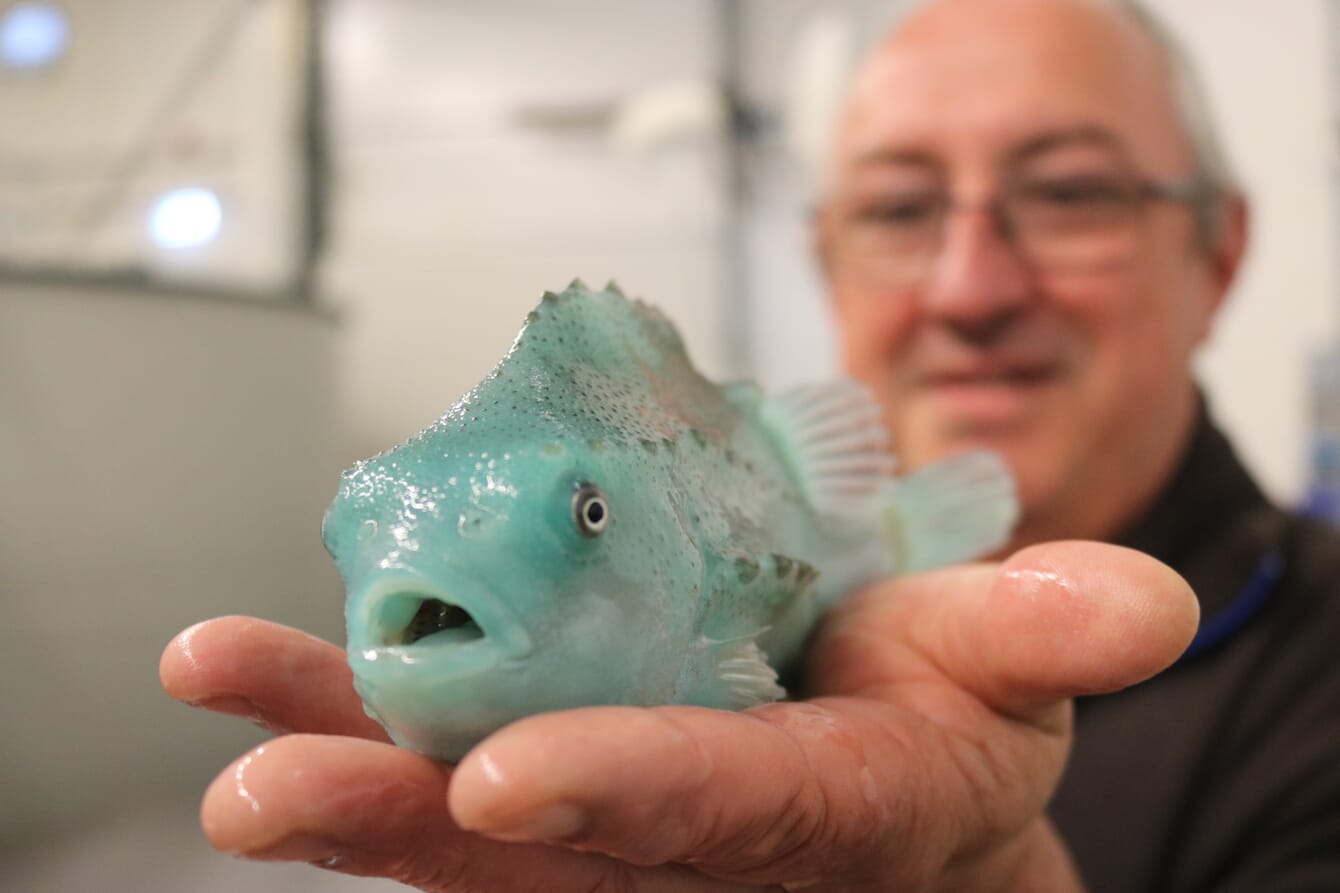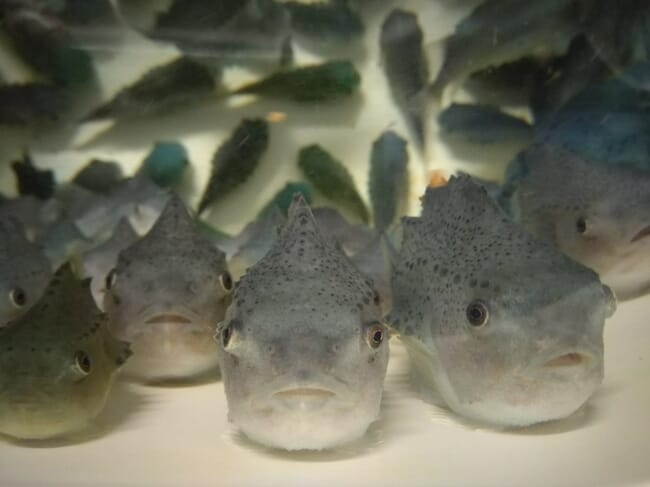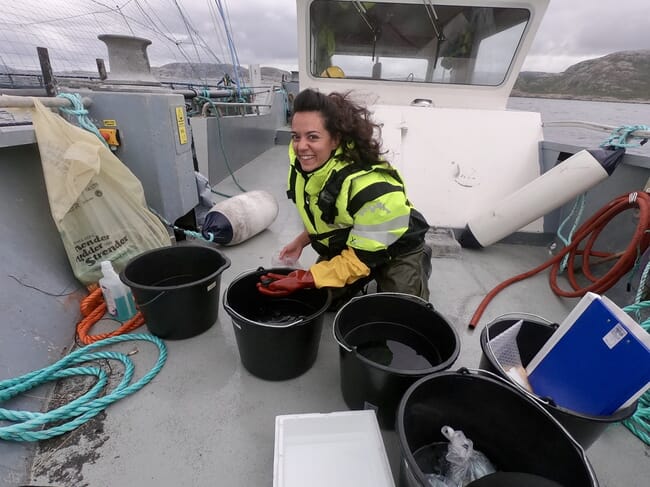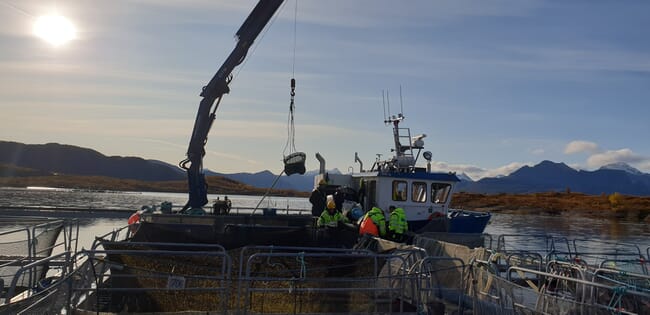
In the last 11 years Reynolds and his research group have gone from establishing proof of concept, to husbandry, to nutritional and feeding requirements for the species in commercial salmon cages
It’s hard to imagine that anyone knows more about lumpfish than Pat Reynolds. Ever since the fish were first considered for picking the sea lice off farmed salmon, Reynolds – and his research group, including Lauris Boissonnot – has been conducting the studies that have helped to pave the way for, assess the efficacy of and fine-tune the use of these cleanerfish.
In the last 11 years his group’s research has stretched from establishing proof of concept, to husbandry, to nutritional and feeding requirements for the species in commercial salmon cages. They have also shown that efficacy of lumpfish grazing on both L. salmonis and C. elongatus can be enhanced through selection and targeted breeding programmes.
In terms of welfare, they’ve mapped the causes of lumpfish mortalities – both in the hatchery phase and in the sea phase – and developed operational welfare indictor models (OWIs) and a handbook with guidance for assessing the health of lumpfish.
We caught up with them to find out how the industry has evolved and where it might be going.

Lumpfish were first utilised as cleaner fish from around 2014 in Norway and later in several other countries © Tim Dempster
How is the use of lumpfish developed in salmon aquaculture over the last decade?
Lumpfish were first utilised as cleaner fish from around 2014 in Norway and later in several other countries. They have been relatively easy to rear, with high rates of survival, and up to 40 million lumpfish were stocked each year in Norway from 2017 to 2020. The past two years have seen a reduction in the number produced and a census is currently underway in Norway to determine production levels.
At the same time lumpfish husbandry has evolved from simply stocking lumpfish together with salmon in sea cages, to gradually adapting salmon pens to accommodate this additional species – through the use of hides, vaccines and proper feeding strategies, for example.
In breeding terms, lumpfish were initially wild-caught, but are now produced in hatcheries, while several breeding programmes to improve their robustness and cleaning efficacy are ongoing.

Advances in lumpfish breeding programmes has meant that the industry is less reliant on wild-caught broodstock
What have been the biggest challenges that the sector has overcome so far?
Husbandry requirements were largely unknown back in 2014, but sea cages have now been adapted to accommodate the species, and salmon farmers have now invested in personnel and infrastructure to ensure their husbandry requirements are met and maintained.
Meanwhile ongoing breeding programmes have reduced the reliance on wild-caught broodstock and improved biosecurity, reducing risk of pathogen transfer both between lumpfish and from lumpfish to Atlantic salmon.
What key challenges still remain?
Developing key methodologies which can be utilised industry-wide to improve survival in sea cages is urgently required. Studies have shown that maintaining good health status can result in lower mortality rates and increased grazing efficacy.
These can be improved with the development of better feeding strategies, more systematic monitoring of welfare, survival, environmental, production conditions and improved vaccine development to safeguard against pathogens. We must also ensure that lumpfish don’t go through mechanical delousing with salmon. We also need to increase the proportion of lumpfish that actually graze on sea lice, through breeding programmes.
Is there pressure on the sector to improve lumpfish welfare and how should this be achieved?

Studies have shown that smaller lumpfish tend to graze on sea lice more than larger specimens
Legislators in Norway are increasingly focusing on lumpfish welfare. Several salmon farming companies have invested in and are implementing routine monitoring of welfare indicators, which is a good tool to identify problems earlier and allows for the implementation of control measures. There is also more and more R&D on lumpfish welfare, which should facilitate solutions due to strong connections between industry and research.
What are the most important factors to ensure that lumpfish perform well as biological controls for sea lice?
Maintaining good welfare in general is essential. Specifically, improving eye health – cataracts remain a potential serious issue for a species that is primarily a visual feeder – by providing access to an appropriate food source is essential. Additionally, a clearer understanding of this phenomenon is needed.
Controlling growth is also important, as studies have shown that smaller individuals tend to graze on sea lice more than larger specimens. Studies have also shown that growth can be readily controlled without compromising welfare, thus extending the operational grazing window for this species.
How do lumpfish compare to other strategies against sea lice and which ones do they work best with?
Lumpfish have been shown to be very effective in controlling sea lice infestation levels in commercial cages as a single treatment strategy.

Reynolds calls for salmon producers to adopt several de-lousing methods to protect their fish from infestations
However, when the sea lice burden increases rapidly and passes a critical threshold then grazing efficacy becomes reduced. The same can apply for mechanical delousing, which is the norm in Norway. There is no real data on direct comparison between lumpfish and chemical delousing methods, as medicinal treatments are not used as much now.
Regardless, it is best to adopt a strategy involving several de-lousing methods. For example, smolts transferred to sea cages can be treated with Emamectin benzoate, which offers protection for several months, after which lumpfish could be deployed, thus offering the salmon protection for around 6-12 months.
Transferring larger smolts to sea cages reduces the time required to attain harvest size, thus using lumpfish with these fish also has the potential for good medium-term protection.
Mechanical delousing is the most frequently used de-lousing method alongside lumpfish, but has not yet been adapted to ensure the cleanerfish avoid being incorporated into the treatment. Research has been undertaken on such a system, but more is required.

The welfare of lumpfish is still a major challenge, but both the aquaculture industry and the scientific community are working towards solutions
How do you see the lumpfish sector developing over the next decade – in Norway and beyond?
The number of lumpfish stocked in sea cages has decreased in the past two years – as those salmon farms who failed to use lumpfish effectively have now decided to stop using them. The ones that found good routines in their use of lumpfish will continue using them and will continue the effort to improve their welfare and cleaning efficacy.
The continuation of breeding programmes will lead to more robust lumpfish with high potential for sea lice grazing. That and the reduced number of fish being produced annually will allow this species to be used efficiently as part of a combined strategy.
What are the main messages you’d like to deliver to critics of the use of lumpfish?
Sea lice on farmed salmon and the consequent use of delousing agents may pose several threats to the environment. The lice can infest wild salmon and negatively impact their populations. Additionally, medicinal delousing agents can be a threat to other species living in the vicinity of the fish farms.
Specifically, other crustaceans may be vulnerable as they share many biological characteristics with sea lice. Mechanical delousing can also be challenging for salmon welfare in fish farms.
An optimised use of lumpfish as a biological de-lousing agent provides an environmentally safe option that also ensures better salmon welfare compared to both medicinal and mechanical delousing options. The welfare of lumpfish is still a major challenge, but both the aquaculture industry and the scientific community have been, and still are, working on finding concreate measures to improve it quickly and durably.




